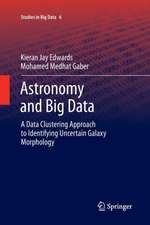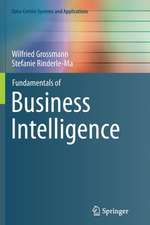Scientific Data Mining and Knowledge Discovery: Principles and Foundations
Editat de Mohamed Medhat Gaberen Limba Engleză Paperback – 20 noi 2014
| Toate formatele și edițiile | Preț | Express |
|---|---|---|
| Paperback (1) | 651.23 lei 6-8 săpt. | |
| Springer Berlin, Heidelberg – 20 noi 2014 | 651.23 lei 6-8 săpt. | |
| Hardback (1) | 657.67 lei 6-8 săpt. | |
| Springer Berlin, Heidelberg – 6 oct 2009 | 657.67 lei 6-8 săpt. |
Preț: 651.23 lei
Preț vechi: 814.04 lei
-20% Nou
Puncte Express: 977
Preț estimativ în valută:
124.63€ • 129.63$ • 102.89£
124.63€ • 129.63$ • 102.89£
Carte tipărită la comandă
Livrare economică 14-28 aprilie
Preluare comenzi: 021 569.72.76
Specificații
ISBN-13: 9783642426247
ISBN-10: 3642426247
Pagini: 412
Ilustrații: X, 400 p.
Dimensiuni: 155 x 235 x 22 mm
Greutate: 0.58 kg
Ediția:2010
Editura: Springer Berlin, Heidelberg
Colecția Springer
Locul publicării:Berlin, Heidelberg, Germany
ISBN-10: 3642426247
Pagini: 412
Ilustrații: X, 400 p.
Dimensiuni: 155 x 235 x 22 mm
Greutate: 0.58 kg
Ediția:2010
Editura: Springer Berlin, Heidelberg
Colecția Springer
Locul publicării:Berlin, Heidelberg, Germany
Public țintă
ResearchCuprins
Background.- Machine Learning.- Statistical Inference.- The Philosophy of Science and its relation to Machine Learning.- Concept Formation in Scientific Knowledge Discovery from a Constructivist View.- Knowledge Representation and Ontologies.- Computational Science.- Spatial Techniques.- Computational Chemistry.- String Mining in Bioinformatics.- Data Mining and Knowledge Discovery.- Knowledge Discovery and Reasoning in Geospatial Applications.- Data Mining and Discovery of Chemical Knowledge.- Data Mining and Discovery of Astronomical Knowledge.- Future Trends.- On-board Data Mining.- Data Streams: An Overview and Scientific Applications.
Textul de pe ultima copertă
With the evolution in data storage, large databases have stimulated researchers from many areas, especially machine learning and statistics, to adopt and develop new techniques for data analysis in different fields of science. In particular, there have been notable successes in the use of statistical, computational, and machine learning techniques to discover scientific knowledge in the fields of biology, chemistry, physics, and astronomy. With the recent advances in ontologies and knowledge representation, automated scientific discovery (ASD) has further, great prospects in the future.
The contributions in this book provide the reader with a complete view of the different tools used in the analysis of data for scientific discovery. Gaber has organized the presentation into four parts: Part I provides the reader with the necessary background in the disciplines on which scientific data mining and knowledge discovery are based. Part II details applications of computational methods used in geospatial, chemical, and bioinformatics applications. Part III is about data mining applications in geosciences, chemistry, and physics. Finally, in Part IV, future trends and directions for research are explained.
The book serves as a starting point for students and researchers interested in this multidisciplinary field. It offers both an overview of the state of the art and lists areas and open issues for future research and development.
The contributions in this book provide the reader with a complete view of the different tools used in the analysis of data for scientific discovery. Gaber has organized the presentation into four parts: Part I provides the reader with the necessary background in the disciplines on which scientific data mining and knowledge discovery are based. Part II details applications of computational methods used in geospatial, chemical, and bioinformatics applications. Part III is about data mining applications in geosciences, chemistry, and physics. Finally, in Part IV, future trends and directions for research are explained.
The book serves as a starting point for students and researchers interested in this multidisciplinary field. It offers both an overview of the state of the art and lists areas and open issues for future research and development.
Caracteristici
Includes supplementary material: sn.pub/extras

























